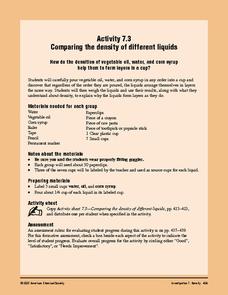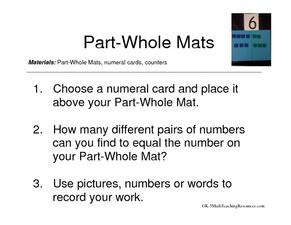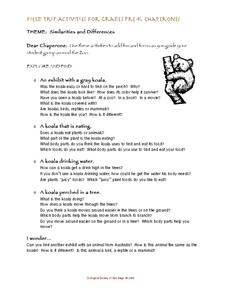Curated OER
Fossil Fuels (Part II), The Geology of Oil
More of a mini-unit than a lesson, these activities lead inquisitors through a survey of oil deposits. In the first part, they read about and view diagrams of sedimentary rock layers that trap oil. Next, they test porosity and...
Curated OER
Plant Parts and their Function
Discover why plants are important to our world. View plant parts and categorize them as stems or buds. Students do a cut and paste of pictures of plants into correct categories. Students also plant a carrot top,and record the growth and...
Illustrative Mathematics
What is a Trapezoid? (Part 2)
This collaborative activity investigates the meaning of a trapezoid and a parallelogram. It begins by presenting two different definitions of a trapezoid. Learners are to reason abstractly the difference between the two definitions and...
Curated OER
Fossil Fuels (Part I), The Geology of Oil
Junior geologists work through three mini-lessons that familiarize them with the formation and location of fossil fuels. Part one involves reading about petroleum and where it comes from via a thorough set of handouts. A lab activity...
American Chemical Society
Dissolving Different Liquids in Water
Not many youngsters realize that solids aren't the only materials that can possibly be dissolved in water. During this investigation, they find out that some liquids can dissolve in water as well. This is part of a unit on solubility,...
Curated OER
Everybody Is Unique: A Lesson in Respect for Others' Differences
Learners of all ages talk about the meaning of the word "unique," and draw a truly unique person, one part at a time. They create a totally unique person, with a head drawn by one student, a torso drawn by another student, and lower body...
American Chemical Society
Comparing the Amount of Acid in Different Solutions
Upcoming chemists use chemical reactions to determine relative pH in two different acids. This is a terrific lesson plan for middle schoolers that can stand alone as a practice in precision and lab skills, or as part of the unit on...
Curated OER
The Circulatory System--Part VI
Students outline a body on butcher paper. Students fill in the circulatory system using materials of various textures. Students decorate all the parts of the circulatory system with art articles, like buttons, yarn, etc.
Illustrative Mathematics
What is a Trapezoid? (Part 1)
Challenge your class to construct a definition for trapezoids. Looking at four examples and four non-examples, students individually create definitions and use them to classify an unknown shape. Allow for small group and whole-class...
American Chemical Society
Comparing the Density of Different Liquids
Learners will like making a liquid layer cake to investigate the relative densities of various liquids: water, oil, and corn syrup. They will also introduce a few solid materials to find out how their densities compare. Standing alone,...
Curated OER
Celery
Here is a wonderful series of lesson plans that use celery to faciliate all sorts of learning. By the end of the lessons, youngsters should know how celery is grown, how celery is used in homes and restaurants, and they will understand...
Curated OER
The Mighty Apostrophe
Here is a well-designed presentation on apostrophes and their many uses. The apostrophe is used in many different ways, and this PowerPoint does a great job of showing how it's used. There is a nice interactive component built in, and...
Curated OER
Parts of Speech
In this parts of speech worksheet, students read about the different parts of speech including past, present, future, singular, plural, and more. Students complete a quiz on the parts of speech where they answer 10 multiple choice...
Curated OER
Digital Parts of Speech
Students investigate different parts of speech by creating digital skits. In this digital education instructional activity, students collaborate in groups to research the Internet for clips and music that represent the different parts of...
Curated OER
Part-Whole Mats
A part-whole mat is a great way to practice simple addition using math manipulatives. Learners choose a number card and place it at the top of their mat. Using counters, they record the different number pairs which would add together to...
Curated OER
Similarities and Differences
Students complete pre-visit and post-visit activities about the koalas they see at the zoo. In this koalas lesson plan, students read books, and answer questions about the similarities and differences they see when they observe the koala...
Curated OER
The First Part Last: Part One
In this The First Part Last comprehension check worksheet, students respond to 25 short answer questions pertaining to part 1 of the Angela Johnson novel to better understand the novel and the author's craft.
Purdue University
Tree Talk
Examining tree rings shows more than just age. The third installment of a five-part Family Nature Program unit has learners examine all parts of trees including tree rings to tell stories about the life of the tree. They then use their...
Curated OER
Let's Learn About Plants!
After listening to From Seed to Plant by Gail Gibbons, learners take a walk around their school looking for plants. They use digital cameras to photograph the plants, then construct a class book which has the identities of the plants,...
Curated OER
Identifying Text Features of a Self-Written Fable
Make learning the parts of a book fun by having pupils construct their own glossary entries, table of contents, and title page. Beginning with a review of text features and a hunt for examples, kids use previously written fables to...
Baylor College
Needs of Plants
What better way to learn about plant life than by creating a class garden? Young botanists start with a brief discussion about radishes before planting seeds and watching them grow. To determine the importance of water, sunlight, and...
PBS
Atlantean Dodgeball
Which team has the advantage? An imaginary story about a game of dodgeball in the lost city of Atlantis demonstrates the ways to compare two quantities. One coach compares the ratios of the numbers of players on each team while the other...
Curated OER
Parts of Speech Word Scramble Worksheet
In this parts of speech worksheet, students complete a word scramble where they unscramble words that are different parts of speech. Students unscramble 15 words.
Curated OER
What Parts of a Plant Do We Eat?
Did you know that tomtoes and cucumbers are actually fruits? Biology or botany beginners read about the function of flowers and fruit and find that some food items commonly called vegetables are, by definition, also fruits! Give learners...
Other popular searches
- Label Different Animal Parts
- Different Parts of Volcano
- Different Parts of Speech
- Different Parts Ofspeech

























